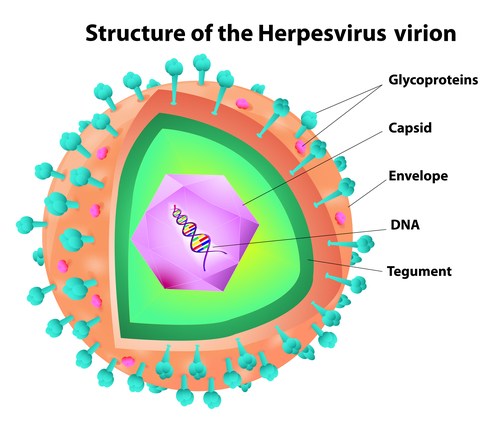Herpesviridae Virus
A Herpesviridae Virus is a double-stranded DNA virus that ...
- Context:
- It can (typically) be a relatively large, monopartite, linear DNA genome encoding 100-200 genes encased within an icosahedral protein cage (with T=16 symmetry) called the capsid, which is itself wrapped in a protein layer called the tegument containing both viral proteins and viral mRNAs and a lipid bilayer membrane called the envelope.
- See: Smallpox Virus, Pustular Vulvovaginitis, Herpes Simplex Virus, Orolabial Herpes, Herpes Simplex, Varicella Zoster Virus.
References
2021
- (Wikipedia, 2021) ⇒ https://en.wikipedia.org/wiki/Herpesviridae Retrieved:2021-6-4.
- Herpesviridae is a large family of DNA viruses that cause infections and certain diseases in animals, including humans. The members of this family are also known as herpesviruses. The family name is derived from the Greek word 'to creep', referring to spreading cutaneous lesions, usually involving blisters, seen in flares of herpes simplex 1, herpes simplex 2 and herpes zoster (shingles). In 1971, the International Committee on the Taxonomy of Viruses (ICTV) established Herpesvirus as a genus with 23 viruses among four groups. As of 2020, 115 species are recognized, all but one of which are in one of the three subfamilies. Herpesviruses can cause both latent or lytic infections. Nine herpesvirus types are known to primarily infect humans, at least five of which – herpes simplex viruses 1 and 2 (HSV-1 and HSV-2, also known as HHV-1 and HHV-2; both of which can cause orolabial herpes and genital herpes), varicella zoster virus (or HHV-3; the cause of chickenpox and shingles), Epstein–Barr virus (EBV or HHV-4; implicated in several diseases, including mononucleosis and some cancers), and human cytomegalovirus (HCMV or HHV-5) – are extremely widespread among humans. More than 90% of adults have been infected with at least one of these, and a latent form of the virus remains in almost all humans who have been infected. [1] The less-common human herpesviruses are human herpesvirus 6A and 6B (HHV-6A and HHV-6B), human herpesvirus 7 (HHV-7), and Kaposi's sarcoma-associated herpesvirus (KSHV, also known as HHV-8). In total, more than 130 herpesviruses are known, some of them from mammals, birds, fish, reptiles, amphibians, and mollusks. Among the animal herpesviruses are pseudorabies virus, the causative agent of Aujeszky's disease in pigs, and bovine herpesvirus 1, the causative agent of bovine infectious rhinotracheitis and pustular vulvovaginitis.
- ↑ In the United States, as many as 15% of adults between 35 and 72 years of age have been infected. National Center for Infectious Diseases
2021
- (Wikipedia, 2021) ⇒ https://en.wikipedia.org/wiki/Herpesviridae#Structure Retrieved:2021-6-4.
- All members of the Herpesviridae share a common structure; a relatively large, monopartite, double-stranded, linear DNA genome encoding 100-200 genes encased within an icosahedral protein cage (with T=16 symmetry) called the capsid, which is itself wrapped in a protein layer called the tegument containing both viral proteins and viral mRNAs and a lipid bilayer membrane called the envelope. This whole particle is known as a virion.
The structural components of a typical HSV virion are the Lipid bilayer envelope, Tegument, DNA, Glycoprotein spikes and Nucleocapsid. The four-component Herpes simplex virion encompasses the double-stranded DNA genome into an icosahedral nucleocapsid. There is tegument around. Tegument contains filaments, each 7 nm wide. It is an amorphous layer with some structured regions. Finally, it is covered with a lipoprotein envelope. There are spikes made of glycoprotein protruding from each virion. These can expand the diameter of the virus to 225 nm. The diameters of virions without spikes are around 186 nm. There are at least two unglycosylated membrane proteins in the outer envelope of the virion. There are also 11 glycoproteins. These are gB, gC, gD, gE, gG, gH, gI, gJ, gK, gL and gM. Tegument contains 26 proteins. They have duties such as capsid transport to the nucleus and other organelles, activation of early gene transcription, and mRNA degradation. The icosahedral nucleocapsid is similar to that of tailed bacteriophage in the order Caudovirales. This capsid has 161 capsomers consisting of 150 hexons and 11 pentons, as well as a portal complex that allows entry and exit of DNA into the capsid. [1] [2]
- All members of the Herpesviridae share a common structure; a relatively large, monopartite, double-stranded, linear DNA genome encoding 100-200 genes encased within an icosahedral protein cage (with T=16 symmetry) called the capsid, which is itself wrapped in a protein layer called the tegument containing both viral proteins and viral mRNAs and a lipid bilayer membrane called the envelope. This whole particle is known as a virion.
2020
- ↑ Liu, Y., Jih, J., Dai, X. et al. Cryo-EM structures of herpes simplex virus type 1 portal vertex and packaged genome. Nature 570, 257–261 (2019). https://doi.org/10.1038/s41586-019-1248-6
- ↑ Das, D., & Hong, J. (2019). Herpesvirus Polymerase Inhibitors. In Viral Polymerases (pp. 333–356). Elsevier. https://doi.org/10.1016/B978-0-12-815422-9.00012-7
